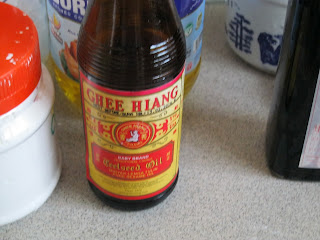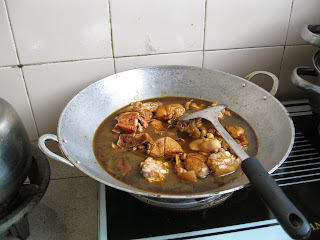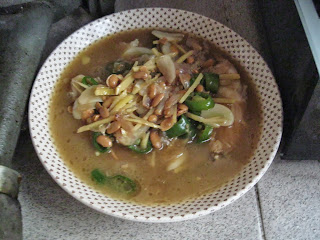Hi there,
Today, mummy decided to cook "Black Vinegar Pig's Totter", (or in Hokkien "tkee ka chor" , or Cantonese "chee keok choh") one of my favourite dishes which I have come to love very much. It has a sweet-sourish sauce full of meaty goodness and a lot of collagen which is very good for arthritis and rheumatism in old people. To cook this dish, you must have the black vinegar sauce, pig's totter (half totter for two people and the whole leg for a family), good ginger (Bentong's the best), a bit of sesame oil and rock sugar for sweetness.
The first thing is to clean the pig's totter which the butcher had cut into bite sizes. Clean the pieces under running water to remove small fragments of bone from the chopping. Use an old shaver to remove any hair remaining on the skin. After that put the chopped pieces aside.
 |
| Picture 1. This is half a pig's totter cut into bite sizes. There are small fragments of bones sticking on the bones and these must be removed so that you may enjoy eating the meat. |
Beside the pig's totter, you must have a bottle of sweeten black vinegar, a small bottle will do, some old ginger, crushed with the pestle, or the cleaver whichever is handy and some rock sugar to taste.
 |
| Picture 2. The picture shows some old gingers, with one piece crushed (inside the bowl) with the pestle on the left side of the picture. There is a small bottle of the black vinegar in the centre of the picture. You can get this from any Chinese sundry shop. You only need to use about a cup of it. The rest you just add water. |
Method:
You need to fry the crushed ginger with sesame oil, to give it the desired aromatic smell and taste. get a good sesame oil. We always buy "Ghee Hiang Sesame Oil". We don't trust any other brand.
 |
| Picture 3. This is the bottle of the branded sesame oil which we trust. Use about 3 to 4 tablespoonful of the oil to fry the old ginger. Do not let the oil burnt. Control the fire. |
 |
| Picture 4. Fry the crushed old ginger in sesame oil until aromatic. Medium heat should be sufficient. When the ginger is done, add in the meat and sear every piece to seal in the flavour. |
 |
| Picture 5. Add in the pieces of meat and fry. Try to sear every piece of meat. Again use medium heat. When the meat is done, then pour in about one cup of black vinegar, depending on the amount of meat. More meat, more black vinegar. |
This is a crucial stage where the meat need to be seared for better flavour. Other people say that it was not necessary to sear the meat, just fry it. You can try both ways. There is no hard and fast rules. Either way, you can still eat them. You may not even taste the difference.
 |
| Picture 6. Black vinegar is added at this stage. Notice the meat pieces are cooked. Use about one cup of vinegar, then pour in about half a litre or more of plain tap water, enough to cover all the meat. |
Use only one cup of the black vinegar and then pour in enough tap water to cover the meat. Let it boil for a while. Then transfer the whole thing into a "Vision Stock Pot" to simmer for about one and a half hours or 90 minutes.
 |
| Picture 7. Tap water is add and then let the whole thing boil for some time. Too much water will dilute the sauce and it would not be nice to drink as soup. Rock sugar is added at this stage. You can also add the rock sugar later when the whole thing is being cooked slowly on the electric cooker. |
After a short while, scoop the whole thing into a "Vision Stock Pot" and place it on an electric cooker to let it simmer for 90 minutes.
 |
| Picture 8. You can buy rock sugar from the supermarket and store it in a plastic bottle to be used later. | | | |
|
 |
| Picture 9. Scoop the whole thing into the stock pot and cook it on an electric cooker. |
When you buy the rock sugar, pick the smaller pieces for easy cooking. The rock sugar is quite hard and difficult to break apart. When you choose the smaller pieces, it will save you the trouble of having to break it up. We don't buy the China ones even though they come in small pieces because they don't taste so nice. So we buy the local ones.
 |
| Picture 10. Set the electric cooker to high and let the whole thing boil for about five minutes. After that lower the heat and let it simmer for 90 minutes or until the meat is soft. At this stage, you can add more rock sugar if the sauce is not sweet enough. |
After the meat is cooked, you can switch off the cooker and it is ready to be served. Serve the dish while it is still hot. The sauce taste very nice when it is hot.
 |
| Picture 11. The finished product ! The mystery of cooking this dish is uncovered. |
After eating this dish, I would say that it tastes better than the ones sold outside. The sauce or soup tastes so good that we polish off the bowl. There is still one more bowl of the sauce left for tomorrow's dinner. I am looking forward to drinking it. The black vinegar is sour enough and the rock sugar is sweet enough and the dish is very balanced. Now, using the notes and the pictures, I can cook this dish myself. "If I can do it, so can you" , so said Martin Yan.
Initially, I thought that cooking the "Black Vinegar Pig's Totter" was very difficult and complicated, but after seeing how mummy did it, it was so simple! I am slowly overcoming my fear of cooking. If mummy can do it, and I have recorded it, then I can do it too! Anybody wants to eat "Black Vinegar Pig's Totter" for dinner? I'll cook for you. I'll put in an extra piece of rock sugar.
Pa.




































+of+IMG_2365.JPG)



















































